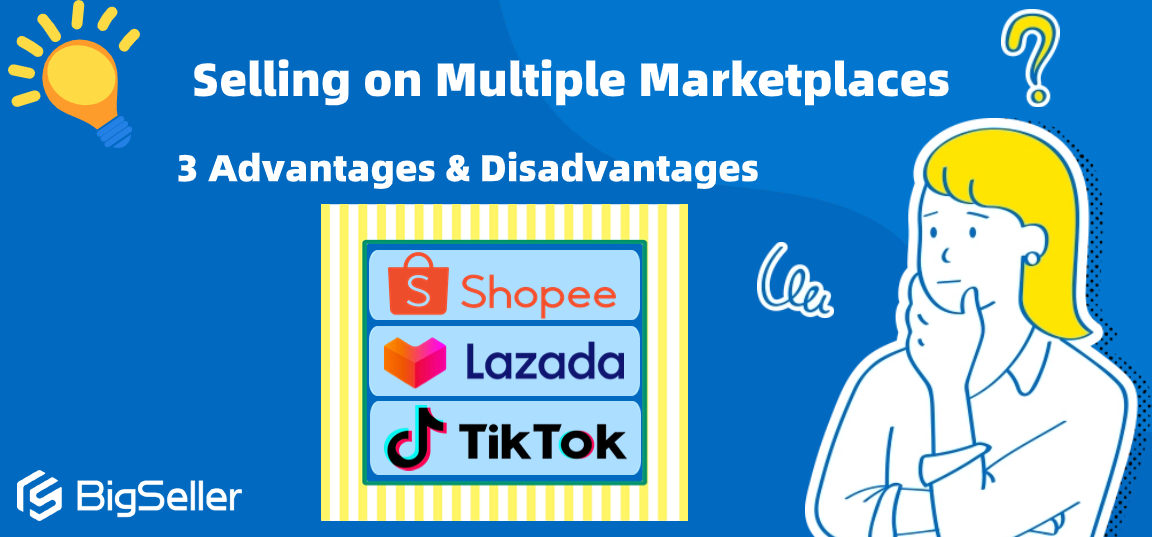3 Advantages & Disadvantages of Selling on Multiple Marketplaces
Jojo Lai 13 May 2024 07:11EN

So, you've been active on a marketplace such as Shopee, Lazada, or TikTok Shop. If you've been at it for a while, you might have observed a slowdown, stagnation, or gradual decline in your sales. But fret not! There's a rationale behind this.
You may have reached or are nearing a saturation point on the platform. Thankfully, there are strategies to address this, and one effective approach is diversifying your sales channels by venturing into other marketplaces.
Expanding beyond a single marketplace enables sellers like you to tap into a wider pool of potential buyers. It's a straightforward concept: the more platforms you're present on, the more exposure your products receive, leading to increased sales.
While the advantages of this strategy are apparent, it's prudent to consider some caveats before branching out to additional platforms. Let's delve into the pros first!
1. Enhanced Product Visibility
Imagine a scenario akin to traditional retail: You're a clothing producer or retailer who strikes a deal with a supermarket chain to sell your wares in one of their outlets. Initially, your products garner attention from the local populace in that vicinity. However, over time, market saturation sets in, impeding further growth.
To counter this, you expand your reach to other areas, diversifying into multiple stores and shopping centers. The same principle applies to online marketplaces. By broadening your presence across various platforms, you amplify the visibility of your products, ensuring they're accessible to a broader audience.
2. Increased Revenue Streams
Expanding on the previous analogy, distributing your products across multiple locations and malls facilitates greater brand exposure. Consequently, you attract more customers, thereby augmenting your revenue streams. This aligns with the progression of a sales funnel, where heightened visibility translates into a larger customer base and, subsequently, increased sales volume.
3. Mitigated Risk
Continuing with the analogy, imagine if the supermarket chain abruptly ceases operations. In such a scenario, solely relying on that outlet for revenue would spell disaster. However, by diversifying your sales channels across multiple stores and malls, you mitigate the risk of business disruption. The same principle applies to online marketplaces; diversification safeguards against potential disruptions stemming from platform closures or operational issues.
Despite these compelling advantages, it's essential to consider certain drawbacks associated with selling on multiple marketplaces.
1. Commission Fees
Most marketplaces levy commission fees on sales conducted through their platforms. These fees typically vary across platforms and may even differ based on product categories. Prior research into each platform's commission structure is crucial to understanding the financial implications of selling on multiple marketplaces. Here are comparation of the most popular eCommerce Marketplaces in Malaysia Different commission rates.
2. Logistics Challenges
Different marketplaces offer varying logistical solutions, ranging from in-house shipping services to external logistics partnerships. Some platforms may handle shipping on behalf of sellers, while others require sellers to manage logistics independently. Additionally, logistical constraints in certain regions may pose challenges for order fulfillment. Thoroughly assessing each marketplace's logistical capabilities is essential for seamless operations.
3. Competitive Landscape
Transitioning to a new marketplace introduces a fresh set of competitors and consumer dynamics. Establishing a foothold in a competitive environment requires strategic planning and adaptation. Sellers must anticipate heightened competition and tailor their business strategies accordingly to thrive in unfamiliar marketplaces.
Below are the top marketplaces to sell in according to data we retrieved from SimilarWeb.
Expanding into multiple marketplaces offers undeniable benefits, including heightened visibility, diversified revenue streams, and risk mitigation. However, sellers must navigate challenges such as commission fees, logistical complexities, and intensified competition. By carefully weighing the pros and cons, sellers can formulate informed strategies to maximize their success across various platforms.


